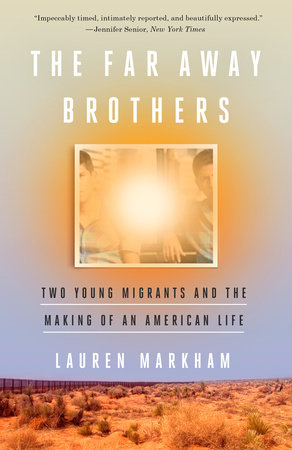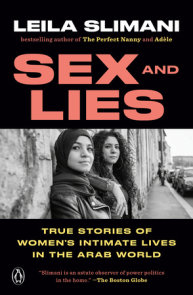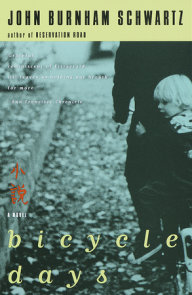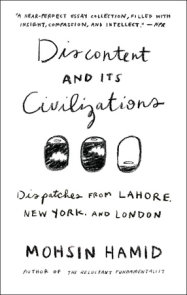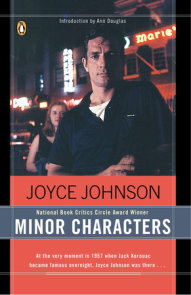TEACHING GUIDE
NOTE TO TEACHERS
Please click on the PDF link at the bottom of this page to download the Teacher’s Guide.
ABOUT THE BOOK
Growing up in rural El Salvador in the wake of the civil war, the United States was a distant fantasy to identical twins Ernesto and Raul Flores—until, at age seventeen, a deadly threat from the region’s brutal gangs forces them to flee the only home they’ve ever known. In this urgent chronicle of contemporary immigration, journalist Lauren Markham follows the Flores twins as they make their way across the Rio Grande and the Texas desert, into the hands of immigration authorities, and from there to their estranged older brother in Oakland, CA. Soon these unaccompanied minors are navigating school in a new language, working to pay down their mounting coyote debt, and facing their day in immigration court, while also encountering the triumphs and pitfalls of teenage life with only each other for support. With intimate access and breathtaking range, Markham offers an unforgettable testament to the migrant experience.
ABOUT THE AUTHOR
Lauren Markham is a writer based in Berkeley, California. Her work has appeared in VQR, VICE, Orion, Pacific Standard, Guernica, The New Yorker.com, on This American Life, and elsewhere. Lauren earned her MFA in Fiction Writing from Vermont College of Fine Arts and has been awarded Fellowships from the Middlebury Fellowship in Environmental Journalism, the 11th Hour Food and Farming Journalism Fellowship, the Mesa Refuge, and the Rotary Foundation. For the past decade, she has worked in the fields of refugee resettlement and immigrant education.
NOTE TO THE TEACHER
As an educator and reporter in Oakland, California, Lauren Markham encounters hundreds of students caught up inside the US immigration system every year. In response to hearing their stories and seeing firsthand the plight of unaccompanied minors in the United States, she decided to write The Far Away Brothers. This book is directly inspired by the personal accounts of two of her students, twin brothers who fled from El Salvador in order to escape the spreading gang violence in their community. In addition to telling their story, Markham also provides crucial context for readers by including information on the many barriers faced by immigrants seeking a new life in the United States. She examines the dangers of crossing the United States–Mexico border, the legacy of violence in El Salvador, the state of detention centers for juvenile immigrants as well as adults, and the complex factors that convince people to risk their livelihoods and their lives in order to enter the United States.
At the beginning of the book, Markham states that her intention is to provide a balanced view on the issues of immigration. Although she occasionally voices her own opinions about issues such as the border wall, her primary goal is to share the experiences of two young men who left their homes in the hopes of finding safety, only to find themselves trapped in a legal system they did not understand and could not navigate on their own. This book encourages students to consider the issue of immigration from the perspective of teenagers who share many of the same dreams for the future as they do. Markham puts a face to the issue of immigration, helping her readers to identify with people from a different culture.
Supporting the Common Core State Standards (CCSS) in Reading Literary Texts and Reading Informational Texts for high school curricula, The Far Away Brothers is an appropriate choice for grades 11–12 in Language Arts, History, Cultural Studies, History, Social Studies, and Writing classes. At the college level, this book is well suited for use in first- or second-year World Literature, American or Central American History, and general Literature courses. Given the pervasive and fraught national conversation surrounding immigration, it could also be used as a First-Year Experience selection.
In the following “Examining Content using Common Core State Standards” section of this guide, activities and writing prompts that encourage critical analysis of The Far Away Brothers have been provided for use in the classroom. They are organized based on the Common Core standards they support. These classroom activities and prompts are designed to encourage students’ thoughtful analysis of and interaction with the text.
For a complete listing of Common Core State Standards, go to: tiny.cc/Standards.
PRE-READING ACTIVITIES
The Far Away Brothers addresses multiple complex issues, including gang violence, US foreign intervention, racism, class prejudice, abuse, the impacts of trauma, and unauthorized immigration. To prepare the class for studying the book, the teacher should begin with a general discussion of some of the issues covered in the story. Though the author provides some information about the tensions in El Salvador and the state of immigration in Texas and California, students will have a better grasp of the issues presented if they first learn the basics of El Salvador’s recent history, including the civil war that led to the rise of gang violence in the country. The class should also review US laws and current events regarding illegal immigration, since these principles directly tie into the story.
Before starting the book, have the students share what information they already know about the immigration system in the United States and the factors that may influence people to enter the country without permission. This will help the teacher determine how much additional information they will need to provide in class in order to give the students the proper context for studying The Far Away Brothers.
The following resources will help introduce some of the concepts covered in the book. The video “Immigration Policy and the U.S. Presidential Election” covers the main issues surrounding illegal immigration and explains current US policy regarding immigration. It also addresses why immigration was such a controversial topic during the 2016 presidential election. The video can be found at: tiny.cc/immigrationpolicyinus. Guides detailing in-depth information on specific US policies regarding illegal and legal immigration are offered by the American Immigration Council at tiny.cc/immigration101. In class, students can break into small groups and select one of the documents offered on the website. They will study their chosen document together, summarize its main points, and share their findings with the class.
Markham touches on the topic of sanctuary cities in the book. If students are unclear on the rules and functions of sanctuary cities, Vox’s video “How Sanctuary Cities Actually Work” can be a useful resource. The video can be found at: tiny.cc/sanctuarycities.
The following activities are designed to prepare students for reading The Far Away Brothers.
During the course of the book, Markham discusses two labels used in the United States for categorizing people: undocumented immigrants and unaccompanied minors. As the book progresses, she reveals the complexities of these labels, including their different interpretations and many of the myths and misconceptions attached to them. Before beginning the book, talk about these two terms in class: What facts do the students already know about undocumented immigrants and unaccompanied minors? What are some of the current perspectives regarding undocumented immigrants and unaccompanied minors in the United States? In what ways are these perspectives accurate, and where do they need revision?
CCSS.ELA-LITERACY.RI.11-12.4 Determine the meaning of words and phrases as they are used in a text, including figurative, connotative, and technical meanings; analyze how an author uses and refines the meaning of a key term or terms over the course of a text (e.g., how Madison defines faction in Federalist No. 10).
Keep a list of what the students already know about undocumented immigrants and unaccompanied minors. As you work through the book together, have the students identify when the author provides the readers with new information about these terms. At the end of the book, reflect as a class on what the students have learned while reading The Far Away Brothers.
CCSS.ELA-LITERACY.W.11-12.8 Gather relevant information from multiple authoritative print and digital sources, using advanced searches effectively; assess the strengths and limitations of each source in terms of the task, purpose, and audience; integrate information into the text selectively to maintain the flow of ideas, avoiding plagiarism and overreliance on any one source and following a standard format for citation.
CLASSROOM ACTIVITY
On page xv, Markham states the purpose behind writing the book: “In a time when immigration is in the daily headlines yet is too often reduced to a matter of binary politics—keep them out or let them in, wall or no wall—this book seeks to offer a complex understanding of why immigrants leave their country, what struggles they endure to get here, and the challenges they face setting roots in a foreign land.”
In class, ask the students to consider what sort of research would be required to write a book that would achieve this purpose. Tell each student to make a list of five potential sources they could use in order to research this topic. In the list, they should explain why each of the sources is reliable, what their strengths and weaknesses are, and what kinds of insight these sources can offer on the complicated subject of immigration.
EXAMINING CONTENT USING COMMON CORE STATE STANDARDS
ELA STANDARDS: READING LITERATURE: GRADES 11 & 12
CLASSROOM ACTIVITY
In the anecdote “The Flood,” Markham explains that the number of adults immigrating into the United States without papers dropped from 1.1 million in 2005 to 326,034 in 2012. At the same time, the number of unaccompanied minors nearly doubled between 2011 and 2012. In 2014, a total of 57,496 unaccompanied minors entered the United States from other countries; in 2017, 40,810 entered federal custody. Markham writes, “It’s the children now, not so much the adults, the parents, who are moving north.”
In a short journal prompt, have the students examine the possible reasons for this drastic change in immigrant demographics, drawing on the information presented in the book. They should answer the following questions: Why did Ernesto, Raul, and the other unaccompanied minors in the book leave their homes while their parents remained behind? What different motivations do adults and children have for leaving their home countries? What new problems does this shift in immigrant demographics create for US immigration services?
CCSS.ELA-LITERACY.RL.11-12.3 Analyze the impact of the author’s choices regarding how to develop and relate elements of a story or drama (e.g., where a story is set, how the action is ordered, how the characters are introduced and developed).
ELA STANDARDS: READING INFORMATIONAL TEXT: GRADES 11 & 12
CLASSROOM ACTIVITY
What does the prologue reveal about what the boys have endured? How does the author use foreshadowing to increase the reader’s investment in the story? In class, keep a timeline showing which details about the boys’ experiences are revealed in what order. Once students have finished the book, look back over the timeline. Knowing how the book ends, would the students have rearranged any of the reveals? How would the narrative be more effective or suspenseful for the reader as a result?
CCSS.ELA-LITERACY.RI.11-12.1 Cite strong and thorough textual evidence to support analysis of what the text says explicitly as well as inferences drawn from the text, including determining where the text leaves matters uncertain.
In the prologue, the boys’ brother Wilber introduces the idea that the United States operates under a different set of unspoken rules than El Salvador. One of the rules, according to Wilber, is: “No work, no pay.” What are some other unspoken rules of living in the United States that the brothers learn?
CCSS.ELA-LITERACY.RI.11-12.2 Determine two or more central ideas of a text and analyze their development over the course of the text, including how they interact and build on one another to provide a complex analysis; provide an objective summary of the text.
CLASSROOM ACTIVITY
Two of the recurring themes of the book are the trials experienced by those seeking to start a new life and people’s social responsibility to one another. Throughout the book, Markham introduces individuals who are struggling to escape their current circumstances but who are unable to do so without help. Part of Markham’s motivation for writing this book was to draw attention to the need for support for immigrants who are struggling to start a new life in the United States. One of the reasons why starting a new life in the United States is so difficult for the twins is navigating the money and power structures of the United States.
While reading the book, have the students keep a list of the differences between life in El Salvador and life in the United States. In class, discuss how these differences make life more difficult for Ernesto and Raul as they attempt to navigate the court system and daily life in California.
Once students have finished the book, revisit the various challenges experienced by the brothers. How did they overcome these challenges? How might the people around them have better helped them on this journey? Now that the students have read an account of what it is like to be an undocumented immigrant, what changes would they make to improve the process of admitting new immigrants into the country? Have the students write a short persuasive essay where they suggest three ways that the United States could make transitioning into its culture easier for new arrivals, thereby increasing their chances at becoming successful, healthy members of society.
CCSS.ELA-LITERACY.RI.11-12.3 Analyze a complex set of ideas or sequence of events and explain how specific individuals, ideas, or events interact and develop over the course of the text.
CLASSROOM ACTIVITY
After reading Chapters One and Two, have the students create character profiles for Ernesto and Raul. Each characteristic should be supported by a quote from the text. As the students continue reading the book, they will keep track of how the story’s events influence the boys’ personalities, actions, and worldviews. At the end of the book, the students will create new character profiles highlighting the ways in which the boys have been shaped by their experiences.
CRAFT AND STRUCTURE
Discuss the way in which Markham decided to structure the chapters. Why did the author place short anecdotes (“The Flood,” “The Churn,” etc.) in between the chapters? What effect does this have on the book? How would the book be different if these anecdotes were not included?
CCSS.ELA-LITERACY.RL.11-12.5 Analyze how an author’s choices concerning how to structure specific parts of a text (e.g., the choice of where to begin or end a story, the choice to provide a comedic or tragic resolution) contribute to its overall structure and meaning as well as its aesthetic impact.
CLASSROOM ACTIVITY
Have the students research current events in El Salvador and write their own short anecdotes that could be placed between the chapters of the book. Like Markham’s anecdotes, these short passages should reinforce one of the book’s themes.
CCSS.ELA-LITERACY.RI.11-12.6 Determine an author’s point of view or purpose in a text in which the rhetoric is particularly effective, analyzing how style and content contribute to the power, persuasiveness, or beauty of the text.
In the section “The Walls,” Markham remarks on the difficulty and cost of building a border wall across the entire United States. In class, have the students examine this section of the book and determine what the author’s perspective is on the border wall. Which specific aspects of the wall does she criticize in this section? Can the reader accurately infer her overall stance on the wall based on these remarks, or is there not enough information provided to make an accurate evaluation?
In the beginning of the book, Markham states that she wishes to provide an open approach to the issue of immigration. Does her offering an opinion about the wall detract from her reliability as a narrator? In the opinion of the students, does Markham manage to present her personal viewpoint without distracting the readers from the narrative?
ELA STANDARDS: WRITING: GRADES 11 & 12
TEXT TYPES AND PURPOSES
From the beginning of the book, Markham establishes the idea of uncertainty and terror. When the boys reach San Francisco, they have, in theory, escaped their violent surroundings. Nevertheless, they are still afraid. On the surface, San Francisco looks much tamer than the cities in El Salvador. However, the brothers observe, “the foreignness was its own quiet form of terror.” In a journal entry, have the students identify a specific situation in which they felt like an outsider or foreign and another in which they felt like an insider. What role did their identity, cultural or otherwise, play in the designation? How might Ernesto and Raul’s response to the same prompt be similar to their own and how it might differ?
CCSS.ELA-LITERACY.W.11-12.3.D Use precise words and phrases, telling details, and sensory language to convey a vivid picture of the experiences, events, setting, and/or characters.
CLASSROOM ACTIVITY
After reading Chapter Four, listen to Radiolab’s “Border Trilogy Part Two: Hold the Line” (tiny.cc/bordertrilogy2). This podcast trilogy shares many of the same topics found in The Far Away Brothers. Part Two deals specifically with the different methods used by the United States to deter or capture illegal immigrants, as well as the physical dangers faced by immigrants during the journey across the border. (Note: This podcast includes some graphic descriptions, particularly between 28:10 and 37:06. When using the podcast in class, you can skip over this section if needed, and the students will still be able to follow the ideas presented by the podcasters.)
While the students listen to the podcast, have them write down similarities between how Radiolab and Markham approach the topic of immigration. What is the primary focus of the podcast? What additional information is provided regarding the security of the border and US policy regarding illegal immigrants? How do the risks faced by Ernesto and Raul compare to those faced by the immigrants studied in the podcast?
CCSS.ELA-LITERACY.W.11-12.7 Conduct short as well as more sustained research projects to answer a question (including a self-generated question) or solve a problem; narrow or broaden the inquiry when appropriate; synthesize multiple sources on the subject, demonstrating understanding of the subject under investigation.
RESEARCH TO BUILD AND PRESENT KNOWLEDGE
The Far Away Brothers focuses primarily on immigrants from El Salvador. Since the brothers come from a country that does not border the United States, their journey is much more arduous than that of other immigrants who live in close proximity to the United States.
Working in small groups, the students will pick a country in Central or South America and research its culture, history, and rate of immigration into the United States. As part of their project, they will find the answers to the following questions:
1. How many people from this country on average enter the United States every year?
2. What are the primary factors motivating this journey?
3. What kinds of support are available for immigrants from this country once they enter the United States (translators, nonprofit organizations, legal advice, etc.)?
4. If possible, find out what the preferred routes into the United States from this country are. How do the citizens of this country get into the United States, and what hazards do they face along the way?
Once the groups have gathered all this information, they will compile it into a Prezi, video, or PowerPoint presentation, which they will then present to the class.
RESOURCES
The Line Becomes a River: Dispatches from the Border, Francisco Cantú: This memoir was written by a former Border Patrol agent about his experiences living and working on the United States–Mexico border. Cantú provides readers with an inside perspective on immigration in the United States. Through this memoir, students can understand the situation from the viewpoint of the agents charged with protecting the border.
Sin Nombre: A film written and directed by Cary Joji Fukunaga in which a Honduran girl and boy involved in a Mexican gang endeavor to cross the US border to escape gage violence.
Radiolab’s “Border Trilogy Part 3: What Remains” (tiny.cc/bordertrilogy3): This podcast is the final installment of Radiolab’s series on the United States–Mexico border and the many dangers faced by immigrants while traveling into the United States. It focuses on the story of Maricela, an Ecuadorian woman who died in the desert while trying to cross into the country. The podcast examines the experiences of her family members during their own journey to the United States and the factors that motivated Maricela to risk her life crossing the desert.
“Killers on a Shoestring: Inside the Gangs of El Salvador,” Óscar Martínez, Efren Lemus, Carlos Martínez, and Deborah Sontag (tiny.cc/elsalvadorgangwar): In The Far Away Brothers, Ernesto and Raul only see the public face of the gangs without understanding what it is like to be in one. This article examines what life is like in the El Salvador gangs and how these gangs affect their communities.
“Immigration Bills,” GovTrack (tiny.cc/govtrack): This website tracks all recent and upcoming bills that address immigration. It includes copies of the bills, who is supporting them, and estimates how likely the bills are to pass.
“Poems on Immigration,” Poetry Foundation (tiny.cc/immigrationpoem): This page includes a list of various poems written about immigration. In class, students can study these poems and compare the viewpoints presented in them to the perspectives shown in The Far Away Brothers.
OTHER WORKS OF INTEREST
The Land of Open Graves: Living and Dying on the Migrant Trail, Jason De León
No Place to Hide: Gang, State, and Clandestine Violence in El Salvador, Laura Pedraza
Fariña, Spring Miller, and James L. Cavallaro
The Distance Between Us: A Memoir, Reyna Grande
Beyond Borders: A History of Mexican Migration to the United States, Timothy J. Henderson
Moving Millions: How Coyote Capitalism Fuels Global Immigration, Jeffrey Kaye
A History of Violence: Living and Dying in Central America, Óscar Martinez
Illegal: Reflections of an Undocumented Immigrant, José Ángel N.
Enrique’s Journey: The Story of a Boy’s Dangerous Odyssey to Reunite with His Mother, Sonia Nazario
The Devil’s Highway: A True Story, Luis Alberto Urrea
The Imaginary Line: A History of the United States and Mexican Boundary Survey, 1848-1857, Joseph Richard Werne
Approaching the Bench from Inside the Immigration Court, William K. Zimmer
ABOUT THIS GUIDE’S WRITER
A Pass Educational Group, LLC has been developing custom, high-quality academic and educational content for our clients since 2009. Learn more about our services at apasseducation.com.
×
Become a Member
Just for joining you’ll get personalized recommendations on your dashboard daily and features only for members.
Find Out More Join Now Sign In








